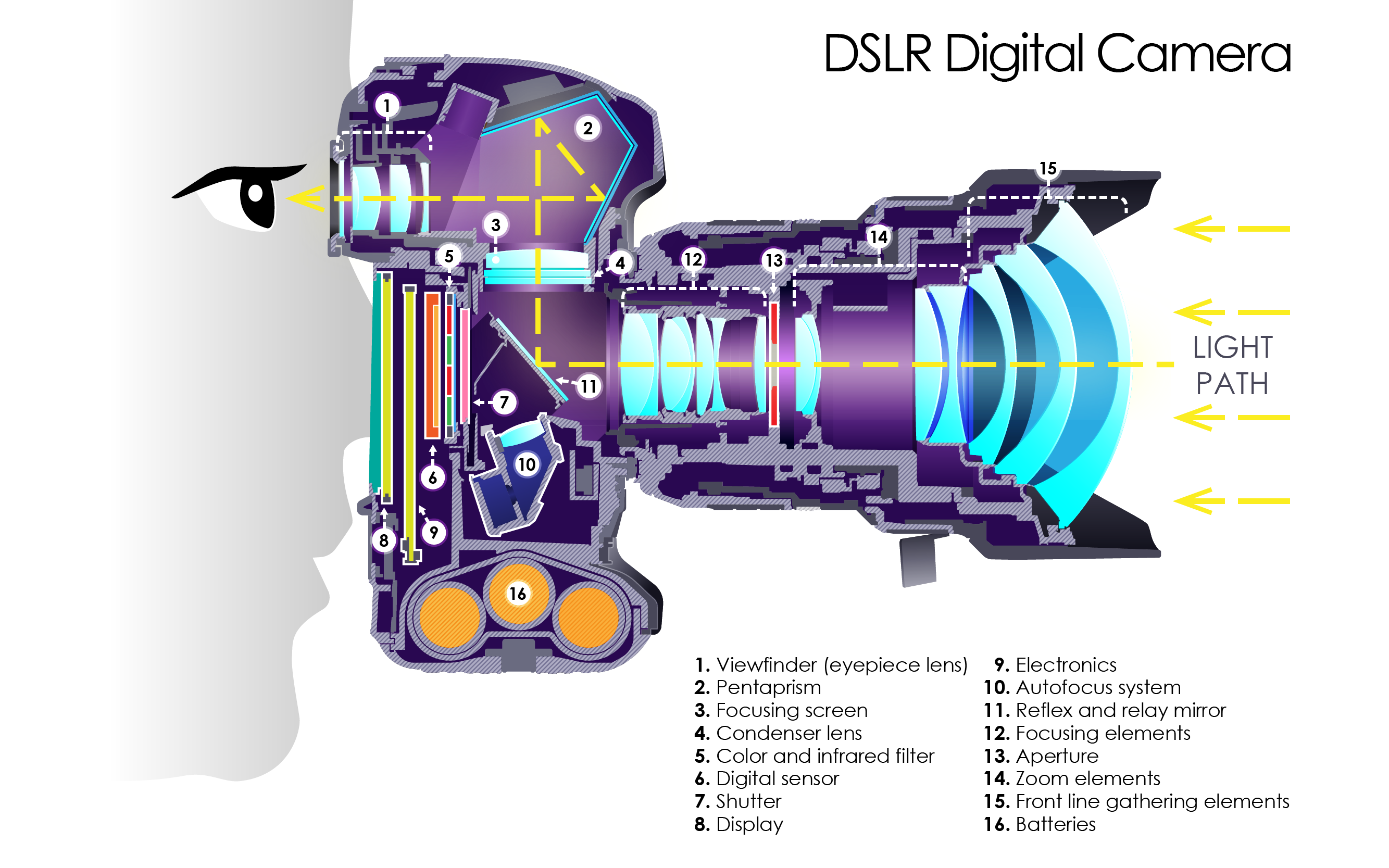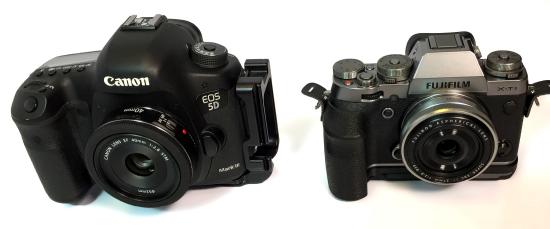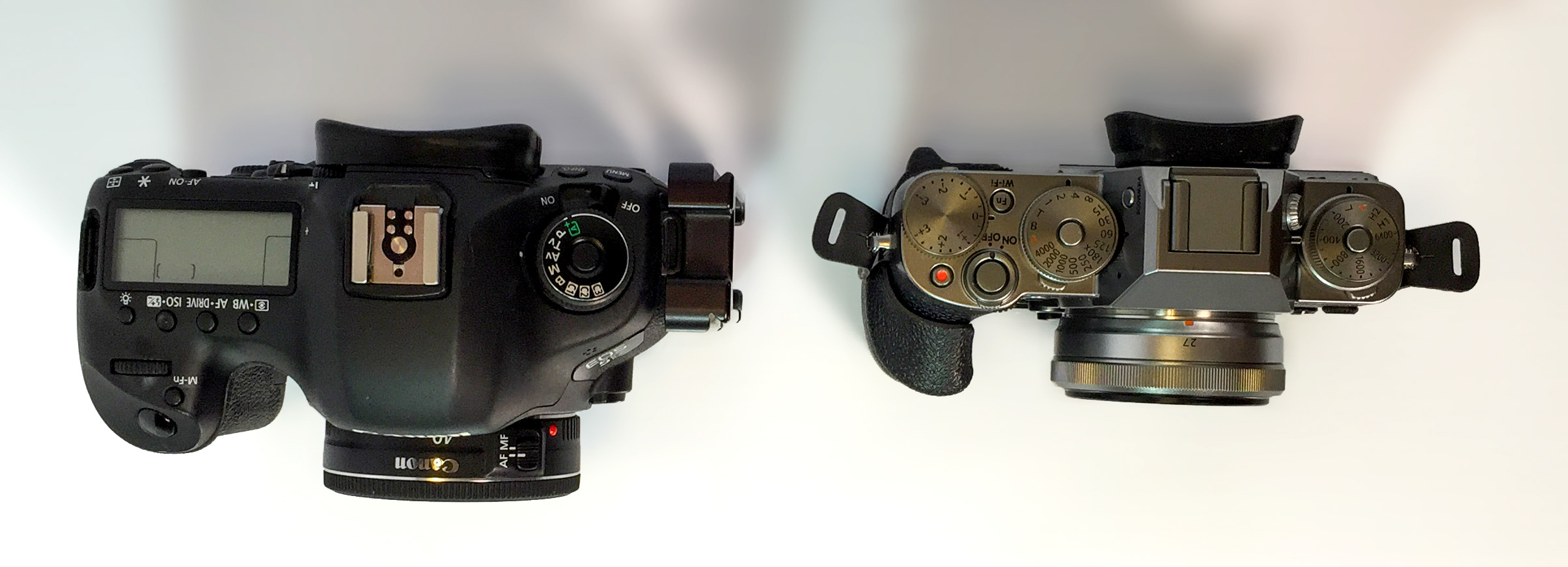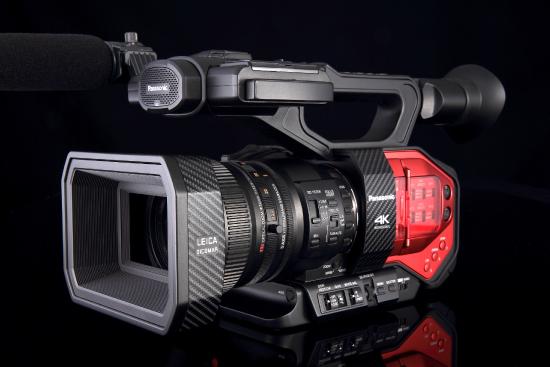7.1: DSLR vs. Mirrorless vs. Camcorders
- Page ID
- 151423
DSLR
DSLR stands for Digital Single Lens Reflex. "Single lens" refers to the ability of the user to see through the same lens as the image sensor using the viewfinder (See Figure 7.1.1 below). Previous cameras did not have this ability, which caused the viewfinder and image sensor to see at slightly different angles. With a DSLR, seeing through the same lens as the image sensor allows the user to see exactly what will be captured. "Reflex" refers to the mirror mechanism that lifts when a picture is taken. When the user takes a picture, the shutter opens and the mirror lifts up to expose the image sensor to light.

DSLR cameras are built to take pictures but now have video functions. The image sensor is a bit larger than many camcorders, which makes the image quality for video excellent and you can get high-quality video in lower light. DSLRs are smaller than camcorders, which makes them easy to pack away. Good image quality can come at a cheaper cost with a DSLR. A video camera of the same image quality is much more expensive. Lastly, you can change lenses, which gives you more options.
Since the primary function of a DSLR is to take pictures, there are reasons why a videographer would choose a camcorder over a DSLR for their production. To start, audio recording controls are minimal on most DSLRs. The input for audio is a mini plug, which is not standard for professional productions. When you want to zoom live, it has to be manual or an exterior mechanism hooked up to the DSLR. Also, recording times are shorter with DSLR, which is around 30 minutes depending on the camera itself. Some will just start a new file and continue recording, but others will just stop recording after 30 minutes. DSLRs also run the risk of overheating. Lastly, the body of the DSLR was not made for video, which can make hand-held video shots more difficult.
Mirrorless
As the name suggests, Mirrorless cameras do not have the mirror mechanism that DSLRs have. Instead, the image sensor is closer to the lens, which may produce higher image quality than a DSLR. The viewfinder (Electronic View Find or EVF) produces a digital image instead of being able to see directly out of the camera lens.


The benefits of a Mirrorless camera versus a camcorder are the same as the DSLR. There are some benefits that make a Mirrorless a better option than a DSLR camera. First, Mirrorless cameras are lighter and smaller in size than DSLRs (See Figure 7.1.2 above), making them even easier to store. The electronic viewfinder (EVF) allows the user to see exposure in real-time, which is not possible when looking directly out of the lens in a DSLR. Also, because there is no mirror mechanism, the Mirrorless cameras have a silent shutter.
The drawbacks to a Mirrorless compared to a camcorder are the same as a DSLR. Compared to a DSLR, a Mirrorless camera can have shorter battery life. Also, electronic viewfinders may have lower image quality than needed, especially in lower light. The EVF quality issue is getting better with newer generations of Mirrorless cameras.
Camcorder
Camcorders are specifically built for recording video and many have a function to take still images. In figure 7.1.3, you can see that the shape of the camcorder is much longer than a DSLR or Mirrorless camera for ease of handling while recording motion. The handle on top makes it easier to carry. Most of the functions you will need are placed on the side of the camera for easy access, like ND filters and controls for white balance, audio, iris, and shutter. The camcorder functions much like DSLR and Mirrorless cameras by allowing light in through the lens to hit an image senor. There is an EVF and a small screen on the side of the camera that are digital images of what is being seen through the lens.

Camcorders are great for long recording times for events or interviews. Most current camcorders have dual card slots with continuous recording, which will switch from one card to the second when memory runs out on the first card. Also, the zoom servo allows you to execute smooth zooms quickly. The built-in XLR connectors and external manual audio recording controls make capturing quality audio easier. The built-in zoom lenses, ND filters, and gain control make switching to different environments fast. Lastly, there are more options for power with camcorders. In addition to batteries, camcorders can use AC plugs to run during longer recordings.
One of the drawbacks of choosing a camcorder is the size. They are bigger than DSLR and Mirrorless and require more physical space for storage. Although camcorders have options for taking still images, they are not built for taking quality stills. With only one zoom lens for the camera, there are no other options for changing lenses. DSLR and Mirrorless image sensors are larger than most camcorder image sensors, which makes the image quality for DSLR and Mirrorless closer to cinema cameras. Lastly, high-end camcorders have a higher ticket price than similar quality DSLR or Mirrorless cameras.
There are advantages and drawbacks to each camera reviewed, but understanding them will help you decide which camera is best for your production and your budget.


